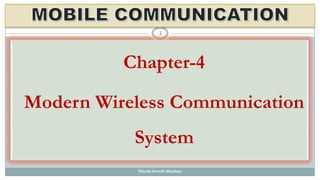The document discusses the evolution of modern wireless communication systems, specifically focusing on 2.5G standards such as HSCSD, GPRS, and EDGE. It outlines their features, data rates, and specifications while detailing the IMT-2000 vision for next-generation mobile telecommunications. Furthermore, it explores the specifications and features of various protocols like IS-136 and IS-95B, emphasizing the progression toward higher data rates and improved service capabilities.

![Dinesh Suresh Bhadane
2
4.1 Evolution for 2.5 G TDMA
standards [12]
HSCSD for 2.5 G GSM
GPRS for 2.5 G GSM and IS-136
EDGE for 2.5G GSM and IS-136
IS-95B for 2.5 G CDMA.
4.2 IMT 2000 [04]
IMT 2000 Vision and Evolution
Aspects.
Radio Spectrum for IMT -2000](https://image.slidesharecdn.com/chapter-4mcomodernwirelesssystem1-200305053935/85/Modern-Wireless-Communication-System-2-320.jpg)












![© 2015, YCMOU, Nashik. Visit Us: www.ycmou.ac.in
15
Users are always connected and online
Users will be charged only for the amount of data that is transported.
User is able to download much more data than that it uploads on the internet.
GPRS Subscribers are automatically tune to dedicated GPRS radio channels
and particular time slots for “Always On” access to the network.
For GSM providers, this new technology will increase data rates of both
circuit switching [HSCSD] and packet switching (GPRS) by a factor of 10 to
15 times .
Provides their own error correction schemes.](https://image.slidesharecdn.com/chapter-4mcomodernwirelesssystem1-200305053935/85/Modern-Wireless-Communication-System-15-320.jpg)






















